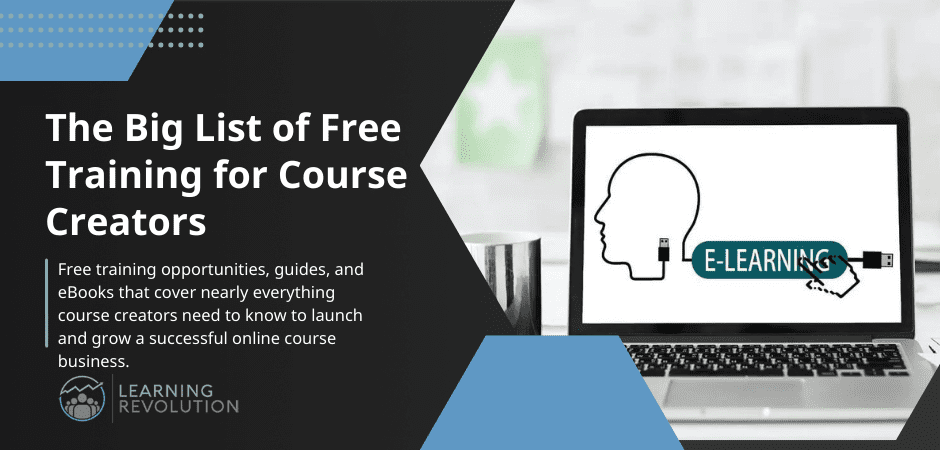

While definitely not the only reason, one very big reason that there is a learning revolution afoot is that it has become way easier to create ecourses. Way back in ye old days of the dot com bubble, when I first got started in e-learning, making an online course was a major pain involving a lot of time and (usually) a lot of money.
No longer.
The Internet has improved and spread by leaps and bounds. We know tons more about how to create effective online courses, and there are now great low-cost options for platforms to help you create and sell courses. It’s a whole new world.
Read on for an overview of ecourses here in the 21st century and guidance on how you can create and sell an ecourse.
What is an ecourse?
An ecourse is a course delivered over the Internet and accessed by students through a computer or mobile device. It may also be referred to as an online course or e-learning course, and it may consist of on-demand, self-paced learning content like videos and text or it may involve live, real-time content delivered by Webinars or live streaming. Increasingly, the best ecourses blend both live and on-demand elements and may also incorporate a learning community approach to support a rich, comprehensive experience for learners.
Ecourses can be affiliated with colleges and universities as part of a broader learning curriculum, or offered and administered by corporations, e-learning organizations, or individuals. The subject matter of ecourses can vary wildly, from traditional academic disciplines to workplace compliance and safety, to hobby and general interest topics.
Basically, if you are an edupreneur, or aspiring edupreneur, ecourses are pretty close to a blank slate for taking your expertise online, teaching the world, and generating significant income.
Why are ecourses so popular?
Ecourses appeal to students of all demographics. There are no barriers between the learner and the classroom, for a start. Many ecourses are self-paced, meaning the students can complete the classes at a time that suits their schedule, and they don’t have to travel miles to do so.
The high accessibility of ecourses (which I write about in Leading the Learning Revolution) makes e-learning the medium of choice for an increasing number of students. As of 2017, there were 81 million global learners registered in Massive Open Online Courses (MOOCs). (See more e-learning stats for course creators here.)
Ecourses are also significantly cheaper than traditional learning. Researchers for personal finance site ValuePenguin determined the average cost of attending college in America in the 2017-18 school year was $20,770 per year for in-state public tuition and $46,950 for nonprofit private schools. By comparison, ecourses at traditional colleges average less than half the cost of attending in person, and the savings only increase for ecourses administered by other organizations or individuals.
Learners come to ecourses for a wide range of reasons, such as looking to improve their job prospects, learn a new skill, or develop a hobby. The diversity of ecourses fuels their appeal to students, and studies show that we are in the midst of a revolution in education, with more people than ever self-teaching using modern technology. Ecourses, which typically present classes in a variety of formats and allow learners to progress at their own speed, are reinventing the way we learn.
What are the benefits of creating an ecourse?
For edupreneurs, ecourses are a great way to reach more learners and build a successful income stream. Setting up an ecourse is relatively inexpensive. All most edupreneurs need is a basic home studio and/or screen recording software, a reasonable understanding of adult learning principles, and a few hours dedicated to writing and marketing the course. There are numerous hosting options available, making creating an ecourse as simple or complex as your capabilities allow.
Many ecourses are hosted on educational platforms such as Thinkific, LearnWorlds, or Podia. These platforms take the technicality out of hosting ecourses, collecting payments, and managing memberships. Some also have a large base of registered learners who are already looking for ecourses and are in a position to buy. As of December 2018, for example, Udemy alone had over 30 million members. While there are many pros and cons to online course platforms, they’re a good place for edupreneurs to start their businesses.


The return potential for ecourses is high because an ecourse is an infinite product. Beyond the initial setup, there are few costs associated with maintaining an ecourse, making them a great source of passive income.
There is also a lot of satisfaction in teaching an ecourse. Passionate edupreneurs can take advantage of a huge global marketplace to reach thousands of new learners and share their knowledge. Spending a few weeks on a product that could foreseeably help people beyond your lifetime isn’t a bad way to create a legacy.
How to create a successful ecourse


There are a number of factors to consider before creating an ecourse. This guide will give you an overview of the main considerations, based on my more than two decades of experience in the online learning industry.
Finding the right subject for your course
Your subject matter is the most important factor, because you have to know something well enough to teach it. The good news is ecourses can be on any subject you can imagine. If you know enough about it to teach, someone else will want to learn. Here’s just a small sampling of courses Learning Revolution readers have created:
- 5 Steps to a Better Website
- Adventure Instead Academy
- Alchemical Past Life Regression
- BERT: Emergency Operations Management
- Business Branding: How to Build a Strong Brand to Grow Your Business
- Communications Masterclasses
- Customer Care: Getting it Right
- Fiduciary Task Management
- Finish Your Pet Project! Self-directed Program with Full Support
- Gestión de Sostenibilidad Empresarial: Plan paso a paso para lograr resultados concretos
- Guaranteed Success: The Secret Science of Compelling Customers to Return
- Heel pain 101: 10 steps to tackle your heel pain
- How to Frame Winning Liberal Messages Use the code “Chimpanzee” to get half off
- How to Master Definite | Indefinite Articles in 7 Days!
- Instant Sight Singing
- InterStrength Interaction Styles™ Certification 2019 B
- Mastering Your Self-Care Routine for Educators
- New Teacher Summer Bootcamp
- More Than Beauty School
- Perpetual Income With Closed-End Funds
- Photoshop for Freelancing, learn the important stuff easily
- POPPIES: Preparación Oposiciones Profesores Profesionales Inglés
- Pour Don’t Push
- Product Licensing vs Venturing
- Profitable Franchise Course: How To Find, Research, And Buy A Profitable Franchise Business
- Remain Relevant
- Sam’s Study Buddy
- Securing Your WordPress site or Blog
- Show & Sell: Interview Skills for Professionals
- The Language Habit
- The Ultimate Guide to Teaching English Online
- Using Energy Alchemy to Thrive
- Your College Essay: Dazzle in 650 Words or Less
- Your Reactive Dog: From Anxious to Zensational
As you can see, the only limit to your course subject is your imagination.
Nonetheless, before building your course, it’s still a smart move to check out the competition. Find out how saturated your market is by searching for existing ecourses in your field. (Here are some tips on using search.) The most successful edupreneurs will identify gaps that can be exploited, so review your competitors’ ecourses and consider what they’re missing. Drawing from your personal knowledge, as well as conducting audience research, will help you create an ecourse that’s relevant, engaging, and unique.
Audience research can seem daunting, but it doesn’t have to be. Start by identifying your target learner and think about who he (or she) is. You probably have an idea from your subject area, but don’t be afraid to turn convention on its head and find a whole new target audience nobody knew existed.
Once you’ve identified your target learner, pay attention to what they’re saying. Online forums, reviews, and social media are great places to explore what people think about your field and how they interact with the people teaching in it. Whenever you’re looking to validate an ecourse idea, it’s important to Search, Listen, Ask, and Test. Don’t be afraid to join the conversation and ask people directly what they want to see in a new ecourse.
Choosing a learning model
Once you’ve decided on an ecourse subject, you need to choose a learning model. Although all ecourses are hosted online, they don’t have to be taught in the same way. You can record videos or screencasts, film presentations and live classes, deliver audio or written lessons, tech by drip email, and more.
For edupreneurs with limited budgets, writing out lessons is the most straightforward option, but it isn’t necessarily the best teaching method for your subject. The thought of creating a video course can be daunting, but statistics show video courses have better learning outcomes, and learners are more likely to choose video over other formats.
Video ecourses come in a variety of formats, so if you’re nervous about appearing before a camera, you don’t have to be. Talking head and piece to camera style videos are common formats for ecourses because they’re easy to film and learners feel a closer sense of connection with a teacher they can see. You can set up a home studio on a budget and start filming your ecourse in no time. Screencasts and slides with a voiceover are also effective video teaching styles, and if you’ve got the skills or budget, you could even produce animated lessons.
Ecourse assessment is also an important consideration as part of your learning model. First consider if the course even needs to be assessed, as you can teach an instructional course without requiring learners to pass. Hobby ecourses are a good example, where learners want to understand more about a subject but will apply the ecourse lessons in their own way.
For edupreneurs who do want to award successful completion, there are a number of ways to test learners’ abilities. Quizzes, tests, written assignments, group projects, presentations, one-on-one assessments and more are all options that can be used throughout or at the conclusion of an ecourse to gauge and grade a learner’s work.
Deciding on delivery platform
Once you’ve decided on the subject and format of your ecourse, you need a place to host it. Hosting anything online can be tricky if you don’t have a lot of technical know-how. Online course platforms have solved this problem by offering simple interfaces where you upload your course, set your price, and let them deal with the technicalities. Some online course platforms are better than others, but if you’re just getting started creating ecourses and are looking for a site that will do the hard work and bring millions of learners to you, they’re a good place to start.
Your host platform is also dependent on your business model. There are a number of ways to generate revenue from ecourses, including ad revenue splitting (for example on YouTube), fixed price, subscriptions, and even free. Depending on the model you choose, Video on Demand services such as Vimeo or Amazon Prime Video Direct might be the better option for your ecourse.
Finally, you can choose to host your course on your own website. This is obviously the most labor-intensive option, as you’ll have to build and maintain the site, configure it to host your course, include payment processors and a paywall, and more. However, you’ll retain complete control over your pricing, appearance, and membership. If you’ve already built a name for yourself in your industry, or have a popular site in your field, self-hosting can be the most successful and lucrative option for your ecourse.
(A couple of great options for hosting courses within your own Web site are Kajabi – which is an all-in-one Web site and online course platform – and LearnDash – which integrates into WordPress. )
Creating an ecourse
Once you’ve got your plan for your ecourse in place, you need to create the content. This can be the hardest part, because there’s relatively little information freely available for edupreneurs on how to go about designing and developing your ecourse. I favor a method developed from the ADDIE approach, which I call A, D, and DIE.
- Analyze:
Identify the major positive outcome you want learners to achieve from your ecourse. To do this, you’ll need to know who your learners are, and what they want to gain from taking your ecourse. - Design:
Create a series of steps the learner will have to take to achieve the major positive outcome, and outline the methods you’ll use to enable them to learn. Think about the skills or knowledge they’ll need, and what educational tools or activities will be most effective at teaching. - DIE (Develop, Implement, Evaluate)
This is the most critical stage, where you test everything you hypothesized in in the Analyze and Design stages, and assume you got it all wrong. Before spending time and money developing a complete ecourse, create a bare bones model and test it against your target learners, revising and retesting as necessary until both sides are satisfied with the results.
Marketing your ecourse


Once you’ve created your first ecourse, it isn’t enough to upload it and forget about it. There are over 9000 registered MOOCs available, and a single online course platform, Udemy, has over 100,000 courses. Whatever your ecourse subject, it’s going to have competition, and you’ll need to promote it organically and advertise it in order for it to sell.
Promoting their ecourse is where many edupreneurs fail to capitalize, but it’s a necessary step to a successful ecourse. Start by speaking to people you know. Post on your social media or blog, tell contacts in your field, and make sure all your online profiles and bios point toward your ecourse. If you’ve built a following in your field before creating your ecourse, let them know when it’s available.
Word of mouth marketing is by far the best advertising for your ecourse. Firstly it’s free, and studies have shown that 92 percent of consumers trust recommendations from friends, whereas 83 percent of people actively dislike seeing ads and consider them false and disruptive.
You can also capitalize on word of mouth by harnessing social proof, sharing success stories and positive feedback for your ecourse, and encouraging learners to leave reviews.
Most edupreneurs will benefit from paid ads as well as organic marketing. You can promote your ecourse online using search engines and market on social media sites such as Facebook.
If you have a website or blog – and you should – encourage subscribers to join an email list so you can send notifications directly to them. Email marketing generates a 3800 percent return on investment, making it one of the most successful marketing methods you can use. In general, you want to do everything you can to build an audience even before you actually have a course to offer, and a high-quality e-mail list is one of the most valuable assets you can create for your business.
Finally, don’t rely just on your own networks. One of the most powerful ways to jumpstart your marketing – especially if you have not started early to build an audience – is to find people and businesses that are already reaching your prospective audience and write a guest post for their blog, be a guest on their podcast, or appear in a Webinar they host. (Be sure you have a clear “call to action” in mind in each case to bring people to your offering – and, in the case of Webinars, ask to have all sign-up e-mails shared with you.)
Bottom Line: Don’t Miss Out on the Revolution
Ecourses are big business, and their popularity is only predicted to grow. Of course, like any major trend, the best time to capitalize is early. It’s less and less early every day, but by following the guidance here you can identify, create, and market your own ecourse and join the learning revolution now.
See also:
- How to Create an Online Course to Sell
- Which Type of Online Course Business Are You? (And Why It Matters)
- How to Sell Courses Online
- How to Structure Your Online Course for Success
- 13 Proven Ways To Increase Online Course Completion Rates
- Cohort-Based Courses: A Detailed Guide for Creators
Table of Contents



Seeing my course listed amongst that wide range of subject matter provided great perspective. I checked each course out! A bunch of great offerings there, and the remainder of your article inspires ways to continue developing my own. Much appreciated, Jeff.
Jeff,
Thank you so much for including my franchise course at Franchise Business University.
I’m grateful!
The Franchise King®
Thanks for sharing it, Joel! – Jeff